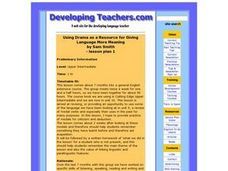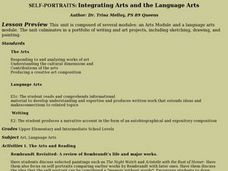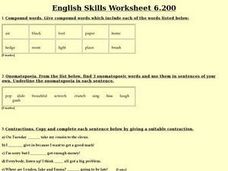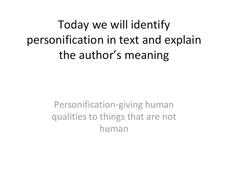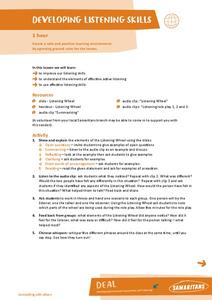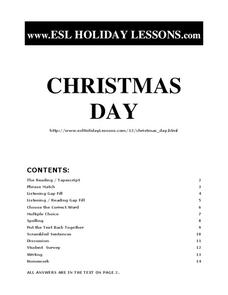Curated OER
Using Our Talents for the Common Good LESSON 2: How Can Our Talents Be Used Together?
Students decide what talents are and how they can be used to help others. They recite a poem and write journal entries about using their talents.
Curated OER
Social Studies: Contributors to the Common Good
Students research historical figures whose contributions had a positive impact on humanity. Their charts include major events, contributions, and changes and are enhanced with drawings of monuments representing the person's life.
Curated OER
Tree of Giving
Learners work together as a team to solve the hypothetical common problem of litter. They give examples of organizations that focus on trying to help others in significant ways (volunteers). Each group maps out their strategy, a tree...
Pennsylvania Department of Education
Giving Things a Name
Students label images seen on an interactive website. In this early writing lesson plan, students do their best to write the name of the object seen on the screen.
Curated OER
Writing Directions for Mathematical Activities
Fifth graders reorganize comic strips to have them make sense, complete outline and organize their thoughts into outline form to explain directions,
and use that outline to complete their own directions for geometry activities.
Curated OER
Using Drama as a Resource for Giving Language More Meaning
Students revise and provide spoken and written practice of modal verbs in the past for criticism.
Curated OER
Giving a Persuasive Speech
Learners examine how to plan their own thoughts, write down specific notes, and prepare to give their speech on a topic from the list. They take a specific side and present their arguments to the class.
Curated OER
What Does Christmas Mean to Me?
Young scholars write an essay entitled "What Does Christmas Mean to Me?" In this writing lesson, students express their feelings about Christmas in an essay. Young scholars discuss ways they have given to others during the Christmas...
Curated OER
Self-portraits: Integrating Arts And the Language Arts
Students look into a mirror and draw their own self-portraits. Then they write a descriptive essay, describing the portrait and the features of their face.
Curated OER
Language Arts: Sound Recognition
First graders practice the short i sound by repeating tongue twisters. Later they write the letter i by using the analogy of drawing a straight line from the "fence" down to the "sidewalk" and putting a "basketball" above it. Other...
Curated OER
Back to School Portfolio Projects
By creating portfolios, you can provide opportunities for students to organize, study, reflect upon, and write about their art.
Curated OER
Play-Doh and the Writing Process
The art of writing is very similar to that of creating a sculpture. They both follow a familiar process.
Curated OER
Eugenics Lesson Plan: Button or Bumper Sticker
Students investigate how fear can cause problems with policies associated with people with disabilities. In this people with disabilities lesson, students study the associated vocabulary, fill in a chart which contains policies that are...
Curated OER
Understanding Other People's Decisions
Students analyze people's choices from different points of view. They read different scenarios and explain how they would react personally in that situation. Then they analyze what they would do in another character's position and...
Lesson Plansos
Guided Reading Activities with Pizzazz
Get the most out of your guided reading lessons with this collection of literacy materials. Offering a system for using color-coded tags to mark pages while reading books, as well as an assortment of comprehension and grammar...
Curated OER
English Skills Worksheet 6.200
There are six word exercises provided here, although they're not necessarily linked together. The first short practice asks learners to give compound words that use the list of words provided. The second asks learners to identify...
Curated OER
Grammar Practice: Restrictive vs. Non-Restrictive Clauses
Go over the basics of restrictive and non-restrictive clauses with this grammar worksheet. After reviewing the concepts, as well as the definitions of parentheticals and appositives, young learners label ten sentences as restrictive or...
Curated OER
Personification
Introduce your young scholars to personification. The literary device is clearly defined and illustrated with clever examples. Opportunities for guided and independent practice using poems by Emily Dickinson and Langston Hughes are also...
Curated OER
Reading Comprehension: Aboriginal Myth About Thunderstorms
Get your anthropologists thinking with this aboriginal myth about thunderstorms. They read the brief myth and answer three comprehension questions. The directions indicate two myths, however there is just one here. Consider extending...
Curated OER
"The False Gems" by Guy de Maupassant
Readers must go beyond the surface level of Guy de Maupassant's story, "The False Gems," to answer the questions on this worksheet. They must draw inferences, evaluate character's actions, and analyze how irony and symbolism give depth...
Appalachian State University
Effective Feedback
Use this well-developed class period to introduce your junior high learners as to how to provide effective feedback concerning their classmates' writing. The plan includes a warm-up, review, introduction, guided and independent practice,...
Samaritans
Developing Listening Skills
Being a good listener is key to building and maintaining positive relationships. Use this lesson as a way to help children connect with others by becoming active listeners and improving their listening skills.
ESL Holiday Lessons
Christmas Day
Celebrary the holiday season fluently with a packet designed for English learners. The resource includes reading comprehension, spelling, scrambled sentences, and writing worksheets focused around Christmas.
K5 Learning
Clara Barton: Civil War Hero
Gain information about Clara Barton, a Civil War hero, and enhance reading comprehension skills with a activity that challenges scholars to read an informational passage and answer five short answer questions.







